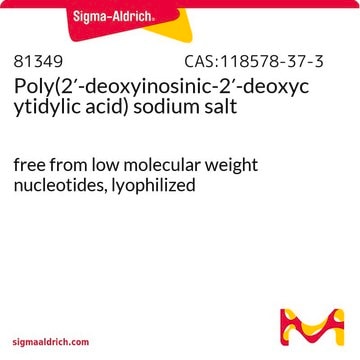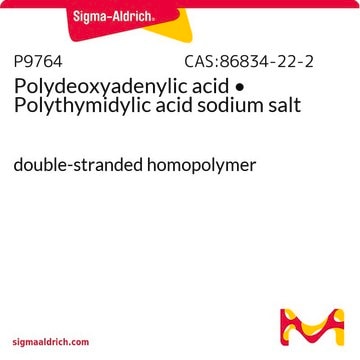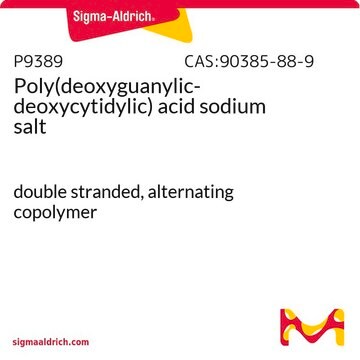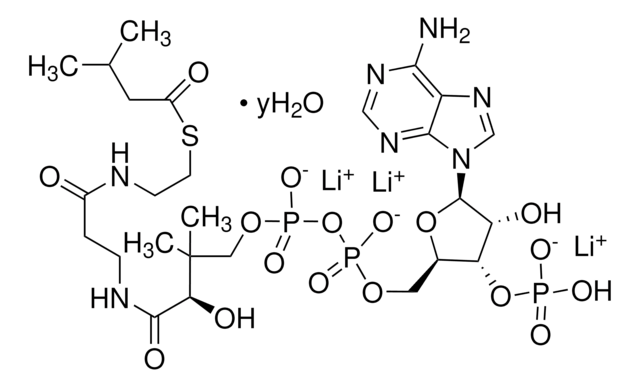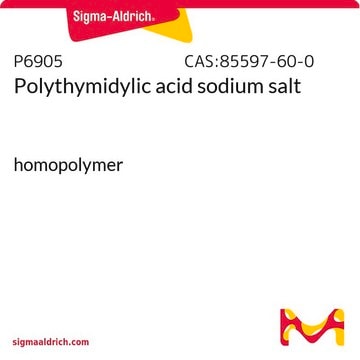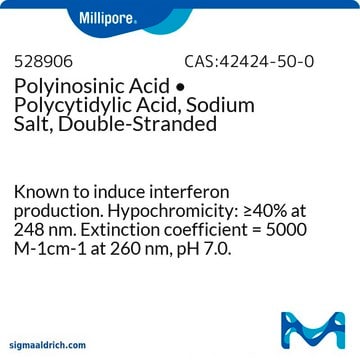P4929
Poly(deoxyinosinic-deoxycytidylic) acid sodium salt
double-stranded alternating copolymer
Synonyme(s) :
Poly(dI-dC) • Poly(dI-dC) sodium salt
Se connecterpour consulter vos tarifs contractuels et ceux de votre entreprise/organisme
About This Item
Produits recommandés
Vous recherchez des produits similaires ? Visite Guide de comparaison des produits
Application
Poly(deoxyinosinic-deoxycytidylic) acid (Poly(dI-dC) • Poly(dI-dC)) is an alternating copolymer used as a DNA substrate for evaluation of DNA methytransfeases, such as DNA-methyltransferase 1 and as double-stranded DNA model for conformational studies of DNA structure dynamics and drug, small molecule, interactions.
Poly(deoxyinosinic-deoxycytidylic) acid sodium salt has been used in a study that synthesized and characterized bis(2-(pyrimidin-2-γl)ethoxy)alkanes and their pharmacological activity. Poly(deoxyinosinic-deoxycytidylic) acid sodium salt has also been used in a study that investigated the growth of calcium carbonate films on LB/LbL matrices.
Poly(deoxyinosinic-deoxycytidylic) acid sodium salt has been used in the electrophoretic mobility shift assay in p65 protein and neuro-2A protein lysate. It has also been used as a substrate in the protein arginine methyltransferase 1 (PRMT1) and DNA methyltransferase 1 (DNMT1) selectivity assay.
Actions biochimiques/physiologiques
Poly(2′-deoxyinosinic-2′-deoxycytidylic acid), poly(dI-dC) is a synthetic DNA substrate. At high salt, Poly(dI-dC) exists in left handed helical conformation and reverts to right-handed form upon decreasing salt. It is used in electrophoretic mobility shift assay (EMSA).
Autres remarques
Double-stranded alternating copolymer
Définition de l'unité
One unit will yield an A260 of 1.0 in 1.0 ml of 20 mM sodium phosphate/100 mM NaCl, pH 7.0 (1 cm light path)
Code de la classe de stockage
11 - Combustible Solids
Classe de danger pour l'eau (WGK)
WGK 3
Point d'éclair (°F)
Not applicable
Point d'éclair (°C)
Not applicable
Équipement de protection individuelle
Eyeshields, Gloves, type N95 (US)
Certificats d'analyse (COA)
Recherchez un Certificats d'analyse (COA) en saisissant le numéro de lot du produit. Les numéros de lot figurent sur l'étiquette du produit après les mots "Lot" ou "Batch".
Déjà en possession de ce produit ?
Retrouvez la documentation relative aux produits que vous avez récemment achetés dans la Bibliothèque de documents.
Les clients ont également consulté
Identification of Selective, Cell Active Inhibitors of Protein Arginine Methyltransferase 5 through Structure-Based Virtual Screening and Biological Assays
Ye F, et al.
Journal of Chemical Information and Modeling, 58(5), 1066-1073 (2018)
Dimitrios Priftis et al.
Langmuir : the ACS journal of surfaces and colloids, 28(23), 8721-8729 (2012-05-15)
A systematic study of the interfacial energy (γ) of polypeptide complex coacervates in aqueous solution was performed using a surface forces apparatus (SFA). Poly(L-lysine hydrochloride) (PLys) and poly(L-glutamic acid sodium salt) (PGA) were investigated as a model pair of oppositely
Chao Bi et al.
Plant molecular biology, 94(1-2), 197-213 (2017-04-10)
It has been known that ABA INSENSITIVE 5 (ABI5) plays a vital role in regulating seed germination. In the present study, we showed that inhibition of the catalase activity with 3-amino-1,2,4-triazole (3-AT) inhibits seed germination of Col-0, abi5 mutants and
Ligang Fan et al.
Nature communications, 11(1), 4947-4947 (2020-10-04)
Pseudomonas syringae is a Gram-negative and model pathogenic bacterium that causes plant diseases worldwide. Here, we set out to identify binding motifs for all 301 annotated transcription factors (TFs) of P. syringae using HT-SELEX. We successfully identify binding motifs for
Meaghan L Clark et al.
Inorganic chemistry, 47(20), 9410-9418 (2008-09-25)
This paper focuses on DNA-binding interactions exhibited by Pt(dma-T)CN(+), where dma-T denotes 4'-dimethylamino-2,2':6',2''-terpyridine, and includes complementary studies of the corresponding pyrr-T complex, where pyrr-T denotes 4'-(N-pyrrolidinyl)-2,2':6',2''-terpyridine. The chromophores are useful for understanding the interesting and rather intricate DNA-binding interactions exhibited
Notre équipe de scientifiques dispose d'une expérience dans tous les secteurs de la recherche, notamment en sciences de la vie, science des matériaux, synthèse chimique, chromatographie, analyse et dans de nombreux autres domaines..
Contacter notre Service technique
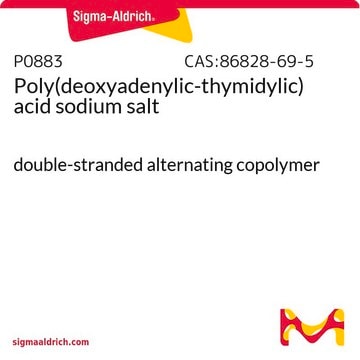
![Poly[d(I-C)] lyophilized, pkg of 10 U (10108812001 [A<sub>260</sub> units]), pkg of 50 U (11219847001 [A<sub>260</sub> units])](/deepweb/assets/sigmaaldrich/product/images/352/091/ef743cea-ccd8-44f1-8f3b-dec5a1e4f5d1/640/ef743cea-ccd8-44f1-8f3b-dec5a1e4f5d1.jpg)
